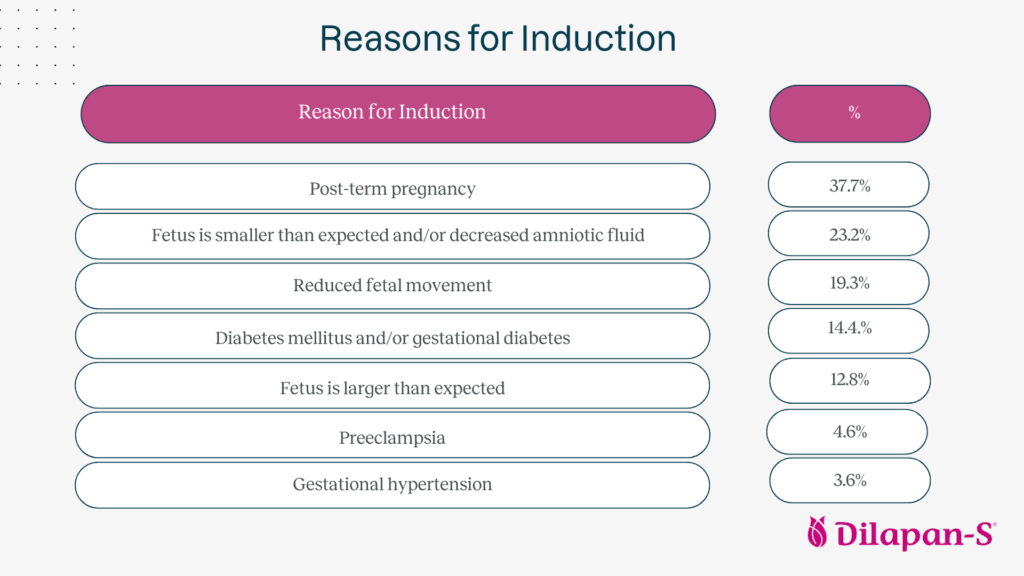
After nine months of anticipation, most mums look forward to spontaneous labour. However, sometimes, practitioners decide that induction of labour (IOL) is necessary.
This can happen for various reasons. Join us as we explain some of these in detail so that you are prepared and better understand what is happening with your body and why labour induction might be the best option for you. If you’d like to read more about IOL in general, we’ve summed up the most important information in the article Understanding labour induction: a guide for expectant mothers.
Elective induction of labour
Sometimes, a low-risk woman chooses to be induced between 39 and 41 weeks for a non-medical reason. This is called an elective induction of labour.
For example, if a mum lives far from the hospital or has a history of very rapid labour and delivery, she may opt for induction. Another common reason is having an above-average-sized baby in a previous pregnancy, with the hope that inducing labour will prevent the baby from growing too large this time.
Elective inductions are not unusual, but it’s essential to have a conversation with your practitioner to discuss the risks and benefits of this option.
When is induction necessary?
Outside of elective inductions, other reasons for induction often arise when giving birth is more beneficial than remaining pregnant. These benefits usually relate to the wellbeing of the mum, baby, or sometimes both.
Making the decision to proceed with IOL is something to discuss with your practitioner. If they recommend it, be sure to ask any questions you have so you fully understand the reasoning behind the decision.

Post-term pregnancy
One of the most common reasons for IOL is a post-term pregnancy. This term describes a situation where the estimated due date has passed without a delivery.
Typically, being several days past the due date is not a cause for concern. However, if 1–2 weeks go by, delivery is usually medically recommended. The placenta, which provides nutrients and removes waste from the baby, begins to age after 40 weeks. It may lose its ability to function at full capacity, impacting the baby’s wellbeing.
Most practitioners prefer to perform IOL by 41 weeks to ensure that neither mum nor baby is in any danger.
Water breaks without contractions
Another common reason is when labour does not begin after the water has broken. It’s common for labour to start within a few hours as long as mum and baby are doing well. However, after 12–24 hours, the risk of infection increases. Most practitioners recommend IOL at this point to help the body move forward with the labour process.
Hypertension
High blood pressure, or hypertension, is another medical reason for induction. If diagnosed before 20 weeks, the condition is called chronic hypertension. After 20 weeks, it’s known as pregnancy-induced hypertension.
Practitioners recommend that all women with hypertension deliver by 39 weeks. If blood pressure becomes uncontrolled or there are signs of preeclampsia, earlier delivery may be necessary, depending on the severity of the condition.
Preeclampsia
Preeclampsia is a complex disorder that can occur during pregnancy, with early symptoms including swelling and high blood pressure. Left untreated, it can affect the kidneys, liver, and heart. Although some medications can manage the condition, delivery is the only definitive treatment.
Diabetes
For mums with diabetes—whether pre-existing or gestational—practitioners often recommend delivery at 39 weeks. Uncontrolled diabetes may call for earlier delivery, especially if it impacts other organs, but unless it leads to a critical situation, early delivery is unlikely.
Fetal health concerns
Labour induction may also be related to fetal health concerns. In these cases, a clinician may detect issues via ultrasound, leading to a decision for earlier delivery.
Factors that may trigger IOL include:
- The size of the fetus, either too big or too small
- The amount of amniotic fluid, whether too low or too high
- Decreased blood flow through the placenta or umbilical cord
In such situations, further tests—such as a biophysical profile or a non-stress test—may be performed to guide the best course of action.
Reasons for induction: data overview
The SOLVE study highlights the most common reasons for labour induction, as shown below.

Conclusion
For some women, labour induction can be a sudden decision, while for others, it’s a planned course of action. Being informed about the process, the reasons for its necessity, and knowing what to expect can be reassuring. If your practitioner recommends induction, it’s likely because delivery is safer for both you and your baby.
Disclaimer: This blog post is for informational purposes only and should not be considered medical advice. Always consult with your healthcare provider to address your individual needs and concerns.









